According to reporting by CityFix, communities around the country are reaping the benefits of the Inflation Reduction Act’s direct pay provision to fund clean energy projects, but that’s not all. By leveraging this funding mechanism, school districts are saving money, air quality is improving, and bolstering energy reliability.
The direct pay provision allows tax-exempt entities to qualify for federal clean energy tax credits that are then received as direct cash payments from the Internal Revenue Service for the first time.
According to the article, “The program currently allows for 12 clean energy and electrification-related credits for technologies like electric vehicles (EVs), EV charging stations, solar panels, wind turbines and battery storage. Organizations that can claim tax credits through direct pay include religious institutions; school districts; rural electric cooperatives; non-profits; and state, local and tribal governments and their associated agencies, including public power utilities.”
In Western North Carolina, direct pay returns are also helping the county manage its response to Hurricane Helene. Since tax credit checks received through elective pay are not earmarked for specific purposes, the over $1 million Buncombe received and helped other organizations claim provided much-needed cash relief. “Elective pay returns could not come at a better time for the community,” said Jeremiah Leroy, Buncombe County’s director of the office of sustainability. “These are much-needed funds to continue normal operations, much less the recovery effort over the coming years.”
Direct pay is also shaping future disaster response and resiliency efforts. In the aftermath of Hurricane Helene, Buncombe County is piloting battery storage projects to help provide power to critical community facilities during future outages.
Related content:
New Tools Simplify Access to Clean Energy Tax Credits for Public Sector and Nonprofits
Unlock Clean Energy Funding with Atlas Public Policy’s New Finance Hub




